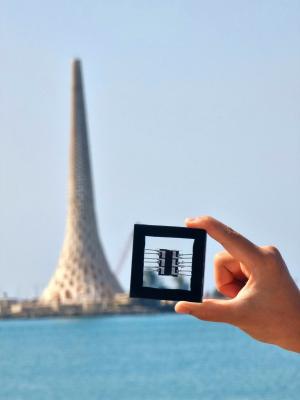King Abdullah University of Science and Technology (KAUST) scientists, along with collaborators from Ulsan National Institute of Science and Technology (UNIST) and Chinese Academy of Sciences (CAS), have reported a new strategy to design perovskite solar cells (PSCs) that improves their stability and raises their efficiency.
Image credit: KAUST
Defects at the top and bottom interfaces of three-dimensional (3D) perovskite photo-absorbers diminish the performance and operational stability of PSCs due to charge recombination, ion migration, and electric-field inhomogeneities. In this recent work, the team demonstrated that long alkyl-amine ligands can generate near-phase pure two-dimensional (2D) perovskites at the top and bottom 3D perovskite interfaces and effectively resolves these issues.
At the rear-contact side, the scientists found that the employed alkyl-amine ligand strengthens the interactions with the substrate through acid-base reactions with the phosphonic acid group from the employed organic hole-transporting self-assembled monolayer molecule, thus regulating the 2D perovskite formation. With this, inverted PSCs with double-side 2D/3D heterojunctions achieved a power conversion efficiency (PCE) of 25.6% (certified 25.0%), retaining 95% of their initial PCE after 1000 hours of 1-sun illumination at 85 degrees Celsius in air.
"Stability is the biggest issue. Because we use low temperatures [in the synthesis], defects are unavoidable. The solution is passivity materials with scalable solutions," said KAUST Postdoctoral Scientist Randi Azmi, the lead author of the study.
Thin layers that are deposited onto the top and bottom of the 3D perovskite interface in the solar cell generally provide the best passivity. To maximize performance, these crystal structures must be controlled for their thickness, purity and dimension.
The research team, led by KAUST Professor Stefaan De Wolf, tested several commercial ligands before identifying the one that best interacted with the 3D perovskites for passivation. This ligand did not wash away during the deposition process, maintaining a pure composition in the thin layers, resulting in an effective heterojunction on both the top and bottom sides of the 3D perovskites.
The scientists show that perovskite solar cells with this new heterojunction have a power conversion efficiency of 25.6%, which is comparable with silicon solar cells and higher than standard perovskite solar cells. More importantly from a stability perspective, the efficiency had relative loss of only 5% after 1000 hours of exposure to high heat, whereas cells designed with other passivity materials saw relative losses of around 20%.
Further, by understanding how the ligand stabilizes the thin layers through a comprehensive characterization analysis that included electron microscopy operated by the KAUST Core Labs as well x-ray scattering and photoelectron spectroscopy will allow for further optimization of the heterojunction for higher stability.
"The elegance of our work is the simplicity and scalability. Other perovskite labs should be able to incorporate our solution into their workflow," said De Wolf.




